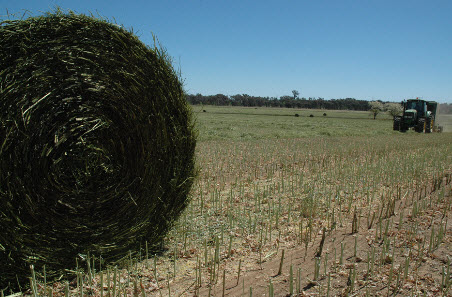Frost-affected crops: assess your options

Producers with crops affected by heavy, prolonged frosts and dry conditions need to be pragmatic in their approach to determining the future of these crops, according to Lisa Castleman, cropping agronomist with Riverina Local Land Services.
"The main options for impacted crops are to harvest as normal, turn it into hay or silage for sale or livestock feeding or graze them off," Lisa said.
"In all of the past severe frosts there have been crops cut for hay unnecessarily. With spring rainfall, some do have the potential to be salvaged, so take the time to examine crop damage carefully."
To determine the best option, Lisa recommends a step-by-step approach:
1. Assess the damage and apply realistic calculations to potential yield as grain or fodder. It is tricky and involves close examination. Lisa’s tips include:
- Appraise the crop in front of you. Each paddock is different and can be affected by sowing date, variety and elevation. Learn how to correctly estimate cereal crop yields by watching this video demonstration by former district agronomist Paul Parker.
- Correct procedures for frost damage inspections involve using a hand lens or a magnifying glass.
- Examine crops more than once. Aim for an interval that covers anthesis (opening of the flower bud) and grain fill.
2. Seek professional advice from industry specialists, such as agronomists. Opportunities could arise to manage a weed problem with cutting or brown manuring an affected crop, or continuing through to harvest to produce feed quality grain (remember to conduct a feed quality test to avoid grain being undervalued). If a crop does not proceed to harvest, leave a standing test strip for final yield evaluation.
3. Establish the nutritional needs of your livestock and if those needs can be met by grazing crops or consuming hay/silage or frost-affected grain, consider:
- The impact of changing the diet of your livestock. Consult an animal nutritionist when introducing canola hay or silage.
- Management of hay or silage production and storage including quality control and moisture content.
4. Make decisions based on good research and consider all options.
"The hardest decisions require caution but often end up being those we give the most thought to and end up being our smartest ones," Lisa said.
Read more of Lisa's advice in this newsletter she prepared covering strategies for farming in dry times.
Here is a list of tools and resources to support producers in making these decisions:
Canola
A video from NSW Department of Primary Industries (DPI) agronomist Rohan Brill on the options for frost-affected canola crops
Canola hay and silage fact sheet from Grains Research and Development Corporation
Canola hay and silage – cutting time and feed quality fact sheet from NSW DPI
All crops
NSW DPI crop salvage calculator
Publications, tools and resources on grazing crops and decision making resulting from the MLA-supported Grain & Graze 3 project
Livestock nutrition
NSW DPI Feeding and Nutrition Guide
Making More From Sheep's Turn Pasture into Product module
More Beef from Pasture’s drought preparedness tool
Supply chain integrity
Understand the impact of treatments on fodder, hay, grazing crops and grain for stock feed and the need to manage grazing and withholding periods prior to slaughter by reading the Livestock Production Assurance requirements.
More information
Lisa Castleman
Senior Land Services Officer (Cropping), Riverina Local Land Services
E: lisa.castleman@lls.nsw.gov.au



